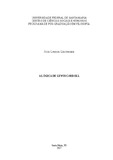| dc.creator | Lindemann, John Lennon | |
| dc.date.accessioned | 2018-03-15T15:09:09Z | |
| dc.date.available | 2018-03-15T15:09:09Z | |
| dc.date.issued | 2017-03-10 | |
| dc.identifier.uri | http://repositorio.ufsm.br/handle/1/12721 | |
| dc.description.abstract | The present dissertation presents an examination of the Carrollian logic through the
reconstruction of its syllogistic theory. Lewis Carroll was one of the main responsible for the
dissemination of logic during the nineteenth century, but most of his logical writings remained
unknown until a posthumous publication of 1977. The reconstruction of the Carrollian
syllogistic theory was based on the comparison of the two books on author's logic, "The
Game of Logic" and "Symbolic Logic". The analysis of the Carrollian syllogistics starts from
a study of the historical context of development of the logic and the developments of
syllogistics previous to the contribution of the author. Situated in the historical period of
algebraical logic, Carrollian syllogistics is characterized as a conservative extension of the
Aristotelian syllogistics, the main innovation is the use of negative terms and the introduction
of a diagrammatic method suitable for the representation of negative terms. The diagrammatic
method of the Carrollian syllogistics presents advances in relation to the methods of Euler and
Venn. The use of negative terms also requires a redefinition of the notion of syllogism,
simplifying and expanding the amount of arguments amenable to logical treatment. Carroll
does not use four, but only three categorical propositions in his syllogistic, with interpretation
of existential presuppositions congruent with a syntactic-existential reading. Carrollian
syllogistics uses some techniques found in the work of algebraists of logic and also made the
same confusions between notions of "class" and "member" that were common in the period.
Convinced of the social utility of logic and dedicated to popularize it, Carroll priorized a
creation of new didactics for the teaching of logic in his works, where he can include his
diagrammatic method of solving syllogisms. Carroll made only scant considerations of his
conception of logic. Based on the small considerations found throughout the study and on the
constant claim of the social utility of logic, it is suggested that Carroll is close to the so-called
pragmatic position, which considers a logic as an instrument of regulation of discourse. | eng |
| dc.language | por | por |
| dc.publisher | Universidade Federal de Santa Maria | por |
| dc.rights | Attribution-NonCommercial-NoDerivatives 4.0 International | * |
| dc.rights.uri | http://creativecommons.org/licenses/by-nc-nd/4.0/ | * |
| dc.subject | Lógica | por |
| dc.subject | Silogismo | por |
| dc.subject | Lewis Carroll | por |
| dc.subject | Logic | eng |
| dc.subject | Syllogism | eng |
| dc.title | A lógica de Lewis Carroll | por |
| dc.title.alternative | The logic of Lewis Carroll | eng |
| dc.type | Dissertação | por |
| dc.description.resumo | A presente dissertação apresenta um exame da lógica carrolliana através da reconstrução de
sua teoria silogística. Lewis Carroll foi um dos principais responsáveis pela divulgação da
lógica durante o século XIX, mas grande parte de seus escritos lógicos permaneceram
desconhecidos até uma publicação póstuma de 1977 e ainda são objeto de poucos estudos. A
reconstrução da teoria silogística carrolliana se deu pelo cotejamento dos dois livros sobre
lógica do autor, a saber, “The Game of Logic” e “Symbolic Logic”. A análise da silogistica
carrolliana parte de um estudo do contexto histórico de desenvolvimento da lógica no qual as
obras se situam e dos desenvolvimentos da silogística anteriores ao aporte do autor. Situado
no período histórico da álgebra da lógica, a silogística carrolliana caracteriza-se como uma
extensão conservativa da silogística aristotélica, cuja principal inovação consiste no uso de
termos negativos e na introdução de um método diagramático de resolução de silogismos
adequado à representação destes termos. O método diagramático da silogística carrolliana
apresenta avanços em relação aos métodos de Euler e Venn. O uso de termos negativos
também exigiu do autor uma redefinição da noção de silogismo, simplificando-a e expandido
a quantidade de argumentos passíveis de tratamento lógico. Carroll não utiliza quatro, mas
apenas três proposições categóricas em sua silogística; com uma interpretação dos
pressupostos existenciais congruente com a leitura sintático-existencial. A silogística
carrolliana utiliza algumas técnicas similares àquelas encontradas no trabalho de algebristas
da lógica que lhe foram contemporâneos e, enquanto um lógico de seu tempo, também
cometeu as mesmas confusões entre as noções de “classe” e “membro” que eram comuns no
período. Convicto da utilidade social da lógica e dedicado a popularizá-la, Carroll priorizou a
criação de novas didáticas para o ensino da lógica em seus trabalhos, onde pode-se incluir o
seu método diagramático de resolução de silogismos, originalmente apresentado como um
jogo de peças. Carroll fez apenas escassas considerações acerca de sua concepção de lógica.
Baseado nas pequenas considerações encontradas ao longo do estudo e na constante
reivindicação da utilidade social da lógica, sugere-se que Carroll estaria próximo da posição
atualmente chamada de pragmática, que considera a lógica como um instrumento de
regulamentação do discurso. | por |
| dc.contributor.advisor1 | Sautter, Frank Thomas | |
| dc.contributor.advisor1Lattes | http://lattes.cnpq.br/2804652028967760 | por |
| dc.contributor.referee1 | Secco, Gisele Dalva | |
| dc.contributor.referee1Lattes | http://lattes.cnpq.br/1081009950294509 | por |
| dc.contributor.referee2 | Teixeira, Rafael Montoito | |
| dc.contributor.referee2Lattes | http://lattes.cnpq.br/8190742787917024 | por |
| dc.creator.Lattes | http://lattes.cnpq.br/9999572531550043 | por |
| dc.publisher.country | Brasil | por |
| dc.publisher.department | Filosofia | por |
| dc.publisher.initials | UFSM | por |
| dc.publisher.program | Programa de Pós-Graduação em Filosofia | por |
| dc.subject.cnpq | CNPQ::CIENCIAS HUMANAS::FILOSOFIA | por |
| dc.publisher.unidade | Centro de Ciências Sociais e Humanas | por |



